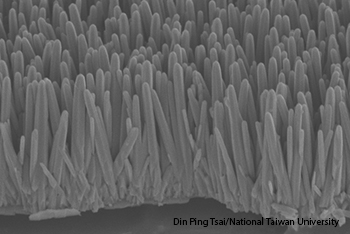
SEM image of an array of upright ZnO nanorods grown on the CD.
Scientists in Taiwan have found a way to reuse old compact optical disks to decontaminate waste water. Physicist Din Ping Tsai at National Taiwan University and his colleagues grew tiny, upright zinc oxide (ZnO) nanorods on the surface of a used optical disk and incorporated it into a wastewater treatment device. The team tested the device with a solution of methyl orange dye, which decomposes when exposed to UV light (Opt. Express 21, 7240).
Photocatalytic optical disks (called PODs for short; otherwise known as CDs) are useful surfaces for ZnO nanorod growth because they are inexpensive, readily available and durable. The ZnO nanorod arrays are, likewise, inexpensive and easy to fabricate on the surface of a POD. A thousand times the width of a human hair, the ZnO nanorods coat the whole surface of the POD (43,275 mm2) and act as a photocatalyst to break up organic molecules like those in sewage.
The group built a sewage treatment device consisting of a cubic-meter-sized box containing the coated POD. As the POD spins, polluted water drips onto it and is distributed into a thin film, which can then be more easily degraded by the UV light source. The system recirculates the water until 95 percent the pollutants are broken down.
A small device with a single POD can process 150 mL of sewage per minute, which is more efficient than other photocatalytic treatments. While that size of device could be used in small-scale treatment, like domestic sewage and urban run-off, the team says future versions could use plasmonic materials and layers of stacked disks to improve efficiency of the POD. The researchers will present the new device at the OSA Frontiers in Optics meeting, 6–10 October, Orlando, Fla., U.S.A.
